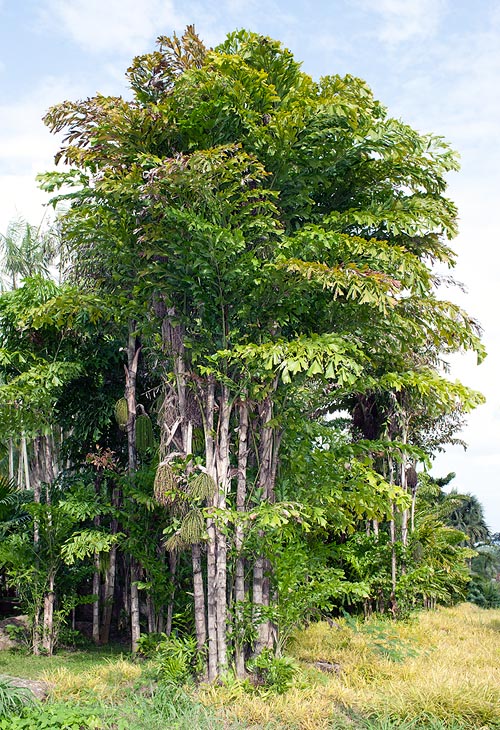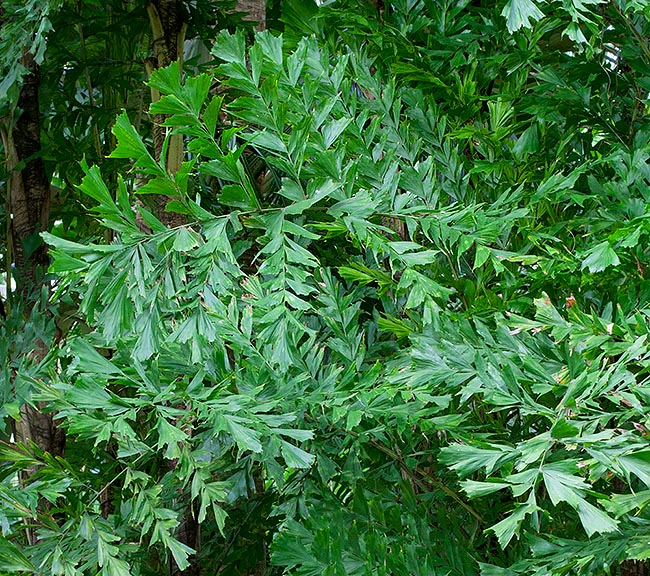Family : Arecaceae

Text © Pietro Puccio

English translation by Mario Beltramini

Caryota mitis is a thickly cespitous, monocarpic species © Giuseppe Mazza
The species is native to Andaman Islands, Borneo, Cambodia, Java, Laos, Myanmar, Nicobar Islands, Peninsular Malaysia, Philippines, South-eastern China, Sulawesi, Sumatra and Thailand, where it grows in the humid forests and in disturbed areas up to about 1000 m of altitude.
The name of the genus is the Latin term, of Greek origin, “caryota” = date, palm fruit; the name of the species is the Latin term “mitis” = gentle, with reference to the lack of spines.
Common names: Burmese fishtail palm, clustering fishtail palm, tufted fishtail palm (English); caryote doux (French); genduru (Javanese); palma caryota (Italian); dudok, mardin, rabuk (Malay); cariota-de-touceira, rabo-de-peixe (Portuguese); Buschige Fischschwanzpalme (German); khuangmu, taorang-daeng (Thai).
Caryota mitis Lour. (1790) is a monoecious species, thickly cespitous, monocarpic (the single stems bear fruits only after having reached the greatest size and then dye), with 4 to 10 m long stems and with 10 to 15 cm of diameter, covered for long time by the foliar bases, fibrous and externally covered by a whitish tomentum.
The leaves, 2-2,8 m long on a 0,8-1,2 m long petiole, are bipinnate, but in the juvenile phase when they are pinnate, ascending, with asymmetric, wedge-shaped, pinnules with apex obliquely truncated and irregularly serrated and fringed, 10-12 cm long, of intense green colour. Ramified bisexual inflorescences, 60-90 cm long, hanging, basipetal (which develop from the top proceeding in subsequent times downwards), with the flowers placed in the typical triad (a female flower between two male); the inflorescence has the phenomenon of the proterandry, the male flowers reach the maturity before the female ones, thus avoiding the self-fecundation and helping the crossed one.
The male flowers are oblong, up to about 1 cm of diameter, with the three petals long 1,2-1,5 cm, the female are globose, of 0,5 cm of diameter, with the three petals about 0,4 cm long; once completed the fructification, the stem dies, but the plant goes on in vegetating from the lateral stems.
The fruits, containing only one seed, are globous, of 1,4-2 cm of diameter, initially green, then reddish orange and finally blackish purple when ripe; the mesocarp is fleshy and contains in abundance needle-like crystals of oxalic acid, toxic if ingested and strongly irritating when in contact with the skin, the fruits are, therefore, to be handled with caution.

The typical bipinnate leaves reach 2-2,8 m on a 0,8-1,2 m petiole © Giuseppe Mazza
It reproduces by seed, which germinates in 4-6 months at the temperature of 22-24 °C, or by division.
It is a strong and fast-growing species widely utilized as ornamental in the tropical climate, subtropical and marginally also warm temperate countries, where, when adult, can bear occasional temperatures up to -2/-3 °C for a very short period, in partial shade as well as in full sun.
For an optimal growth, it requires well drained soils, regular and abundant waterings, keeping the soil almost constantly humid, even if it can stand periods of dry, but with a slow-down in the growth, and nitrogenous fertilizations.
Young specimens are utilized for the decoration of spacious interiors in a very luminous position, with lowest temperatures over the 14-15 °C; it is susceptible to attacks of parasites, such as cochineals and mites, it is therefore to be checked periodically in order to be able to intervene with the suitable products.
Some local populations collect, by incising the peduncle of the young inflorescences, the lymph, very sweet, for producing sugar or, after fermentation, an alcoholic beverage; furthermore, the central part of the stem, rich in amid (sago), is at times utilized as food, even if of lesser quality than the one gotten, for instance, from the Caryota urens.
Caryota mitis was assessed in 2018 by The IUCN Red List of Threatened Species in the category of “LC, Least Concern”.
Synonyms: Caryota furfuracea Blume ex Mart. (1838); Caryota propinqua Blume ex Mart. (1838); Caryota sobolifera Wall. ex Mart. (1838); Drymophloeus zippellii Hassk. (1842); Caryota sobolifera Wall. (1848); Thuessinkia speciosa Korth. (1855); Caryota javanica Zipp. ex Miq. (1856); Caryota griffithii Becc. (1871); Caryota nana Linden (1881); Caryota speciosa Linden (1881).
→ For general notions about ARECACEAE please click here.
